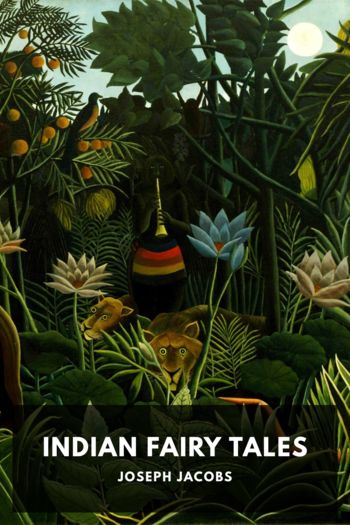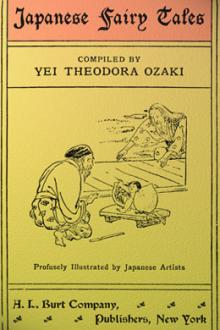Indian Fairy Tales by Joseph Jacobs (best books to read for students TXT) 📕

- Author: Joseph Jacobs
Book online «Indian Fairy Tales by Joseph Jacobs (best books to read for students TXT) 📕». Author Joseph Jacobs
Source.—Pantschatantra, V ix, tr. Benfey, II 345–6.
Parallels.—Benfey, in § 209 of his “Einleitung,” gives bibliographical references to most of those which are given at length in Prof. M. Müller’s brilliant essay on “The Migration of Fables” (Selected Essays, I 500–76), which is entirely devoted to the travels of the fable from India to La Fontaine. See also Mr. Clouston, Popular Tales, II 432 seq. I have translated the Hebrew version in my essay, “Jewish Influence on the Diffusion of Folktales,” pp. 6–7. Our proverb, “Do not count your chickens before they are hatched,” is ultimately to be derived from India.
Remarks.—The stories of Alnaschar, the Barber’s fifth brother in the Arabian Nights, and of La Perette, who counted her chickens before they were hatched, in La Fontaine, are demonstrably derived from the same Indian original from which our story was obtained. The travels of the “Fables of Bidpai” from India to Europe are well known and distinctly traceable. I have given a rough summary of the chief critical results in the introduction to my edition of the earliest English version of the Fables of Bidpai, by Sir Thomas North, of Plutarch fame (London, D. Nutt, “Bibliothèque de Carabas,” 1888), where I have given an elaborate genealogical table of the multitudinous versions. La Fontaine’s version, which has rendered the fable so familiar to us all, comes from Bonaventure des Periers, Contes et Nouvelles, who got it from the Dialogus Creaturarum of Nicholaus Pergamenus, who derived it from the Sermones of Jacques de Vitry (see Prof. Crane’s edition, No. LI), who probably derived it from the Directorium Humanae Vitae of John of Capua, a converted Jew, who translated it from the Hebrew version of the Arabic Kalilah wa Dimnah, which was itself derived from the old Syriac version of a Pehlevi translation of the original Indian work, probably called after Karataka and Damanaka, the names of two jackals who figure in the earlier stories of the book. Prof. Rhys-Davids informs me that these names are more akin to Pali than to Sanskrit, which makes it still more probable that the whole literature is ultimately to be derived from a Buddhist source.
The theme of La Perette is of interest as showing the literary transmission of tales from Orient to Occident. It also shows the possibility of an influence of literary on oral tradition, as is shown by our proverb, and by the fact, which Benfey mentions, that La Fontaine’s story has had influence on two of Grimm’s tales, Nos. 164, 168.
VI The Magic FiddleSource.—A. Campbell, Santal Folktales, 1892, pp. 52–6, with some verbal alterations. A Bonga is the presiding spirit of a certain kind of rice land; Doms and Hadis are low-caste aborigines, whose touch is considered polluting. The Santals are a forest tribe, who live in the Santal Parganas, 140 miles N.W. of Calcutta (Sir W. W. Hunter, The Indian Empire, 57–60).
Parallels.—Another version occurs in Campbell, p. 106 seq., which shows that the story is popular among the Santals. It is obvious, however, that neither version contains the real finish of the story, which must have contained the denunciation of the magic fiddle of the murderous sisters. This would bring it under the formula of “The Singing Bone,” which M. Monseur has recently been studying with a remarkable collection of European variants in the Bulletin of the Wallon Folklore Society of Liège (cf. English Fairy Tales, No. IX). There is a singing bone in Steel-Temple’s Wideawake Stories, pp. 127 seq. (“Little Anklebone”).
Remarks.—Here we have another theme of the common store of European folktales found in India. Unfortunately, the form in which it occurs is mutilated, and we cannot draw any definite conclusion from it.
VII The Cruel Crane OutwittedSource.—The Baka-Jātaka, Fausböll, No. 38, tr. Rhys-Davids, pp. 315–21. The Buddha this time is the Genius of the Tree.
Parallels.—This Jātaka got into the Bidpai literature, and occurs in all its multitudinous offshoots (see Benfey, “Einleitung,” § 60) among others in the earliest English translation by North (my edition, pp. 118–22), where the crane becomes “a great Paragone of India (of those that liue a hundredth yeares and neuer mue their feathers).” The crab, on hearing the ill news “called to Parliament all the Fishes of the Lake,” and before all are devoured destroys the Paragon, as in the Jataka, and returned to the remaining fishes, who “all with one consent gave hir many a thanke.”
Remarks.—An interesting point, to which I have drawn attention in my Introduction to North’s Bidpai, is the probability that the illustrations of the tales as well as the tales themselves, were translated, so to speak, from one country to another. We can trace them in Latin, Hebrew, and Arabic





Comments (0)